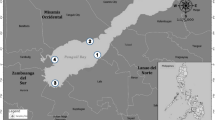Abstract
This study assessed sediment pollution along the Tunisian coast using the sediment contact assay with embryo and larval life-stages of the clam Ruditapes decussatus. Sediment was collected from four sites for testing: Mahres, Monastir lagoon, Zarat and Chebba. Embryo development was significantly (p < 0.05) inhibited in sediment at concentrations ≥5 g L−1 from the Mahres and Monastir sites, and ≥25 g L−1 with sediment from the Zarat site. Sediment from the Chebba site had no effect at concentrations up to 125 g L−1. Compared to the control, the percentages of larval mortality were significantly higher in sediment from Monastir, Mahres and Zarat at sediment concentrations ≥25 g L−1; mortality increased with increasing sediment concentration to 50.1 %, 39.5 % and 31.2 % respectively at 125 g L−1. Chebba sediment did not affect the survival of larvae.



Similar content being viewed by others
References
ASTM (1995) American Society for Testing and Materials, Standard guide for conducting static acute toxicity tests with echinoid embryos. E 1563-95, Annual book of ASTM standards, 11.05: 1029–1046 Philadelphia, PA
ASTM (1998) Standard guide for conducting static acute toxicity tests starting with embryos of four species of saltwater Q5 bivalve molluscs. E7 24–98, 21
Azri C (2000) Contribution des sources mobiles et fixes à la pollution atmosphérique dans la région de Sfax (Tunisie). Thèse de Doctorat de l’Université de Tunis II
Ben Mansour H, Mosrati R, Ghedira K, Chekir L (2011) Decolorization of textiles finishing wastewater by Pseudomonas putida: toxicity assessment. Environ Eng Sci 28:489–495
Bouraoui Z, Banni M, Chouba L, Ghedira J, Clerandeau C, Jebali J, Narbonne JF, Boussetta H (2009) Monitoring pollution in Tunisan coasts using a scale of classification based on biochemical markers in worms Nereis diversicolor (Hediste). Environ Monit Assess 164:691–700
Chapman PM (2000) The sediment quality triad: then, now and tomorrow. Int J Environ Pollut 13:351–356
Chiffoleau JF, Auger D, Boutier B, Rozuel E, Truquet I (2003) Dosage de certains métaux dans les sédiments et les matières en suspension par absorption atomique. Méthodes d’analyse en milieu marin (Ed.) IFREMER, p. 45
Eertman RHM, Groenink-van Emstede M, Sandde B (1993) The effects of the polycyclic aromatic hydrocarbons fluoranthene and benzo(a)pyrene on the mussel Mytilus edulis, the amphipod Bathyporeia sarsi and larva of the oyster. Crassostrea gigas, BEONEfecten 50p
Emmens CW (1948) Principles of biological assay. Chapman and Hall Ltd, London
Fathallah S, Medhioub MN, Medhioub A, Kraiem MM (2012) Sediment toxicity bioassays using Ruditapes decussatus embryos and larvae to assess the contamination in four sites on the coast of Tunisia. Soil Sed Contam 21:351–363
Gargouri D, Azri C, Serbaji MM, Jedoui Y, Montacer M (2011) Heavy metal concentrations in the surface marine sediments of Sfax Coast, Tunisia. Environ Monit Assess 175:519–530
Geffard O, Geffard A, His E, Budzinski H (2003) Assessment of the bioavailability and toxicity of sediment-associated polycyclic aromatic hydrocarbons and heavy metals applied to Crassostrea gigas embryos and larvae. Mar Pollut Bull 46:481–490
Hamza-Chaffai A, Pellerin JC (2003) Health assessment of a marine bivalves Ruditapes decussatus from the Gulf of Gabès (Tunisia). Environ Int 28:609–617
His E, Seaman MNL, Beiras R (1997) A simplification: the bivalve embryogenesis and larval development bioassay method for water quality assessment. Water Res 31(2):351–355
His E, Beiras R, Seaman M (1999) The assessment of aquatic contamination: bioassays with bivalve larvae. Adv Mar Biol 37:1–178
Hubner R, Astin KB, Herbert RJH (2009) Comparison of sediment quality guidelines (SQGs) for the assessment of metal contamination in marine and estuarine environments. J Environ Monit 11(4):713–722
ICES (1997) International Council for the Exploitation of the Sea, Report of the ICES advisory committee on the marine environment
ISO11466 (1995) Soil quality—extraction of trace elements soluble in aqua regia
MacDonald DA, Matta MB, Field LJ, Cairncross C, Munn MD (1993) The coastal resource coordinator’s bioassessment manual. Report No. HAZMAT 93-1 (revised). Seattle, WA. National Oceanic and Atmospheric Administration (NOAA); 147 pp
Matthiessen P, Bifield S, Jarrett F, Kirby MF, Law RJ, McMinn WR, Sheahan DA, Thain JE, Whale GF (1998) An assessment of sediment toxicity in the River Tyne Estuary, UK by means of bioassays. Mar Environ Res 45(1):1–15
Pelletier M, Kuhn-Hines A (1994) Utility of the bivalve Mulinia lateralis as a marine TIE test species, 1994 SETAC Conference, Denver, CO
US EPA (2000) Estuarine and coastal marine waters: bioassessment and biocriteria Technical guidance. US EPA 822-B-00-024
Zhang L, Ye X, Feng H, Jing Y, Ouyang T, Yu X et al (2007) Heavy metal contamination in western Xiamen Bay sediments and its vicinity, China. Mar Pollut Bull 54:974–982
Author information
Authors and Affiliations
Corresponding author
Rights and permissions
About this article
Cite this article
Fathallah, S., Medhioub, M.N. & Kraiem, M.M. Sediment Contact Assay Using the Carpet Shell Clam, Ruditapes decussatus L., Embryos and Larvae for Assessing Contamination Levels of Four Sites in Tunisian Coast. Bull Environ Contam Toxicol 90, 611–615 (2013). https://doi.org/10.1007/s00128-013-0970-2
Received:
Accepted:
Published:
Issue Date:
DOI: https://doi.org/10.1007/s00128-013-0970-2




